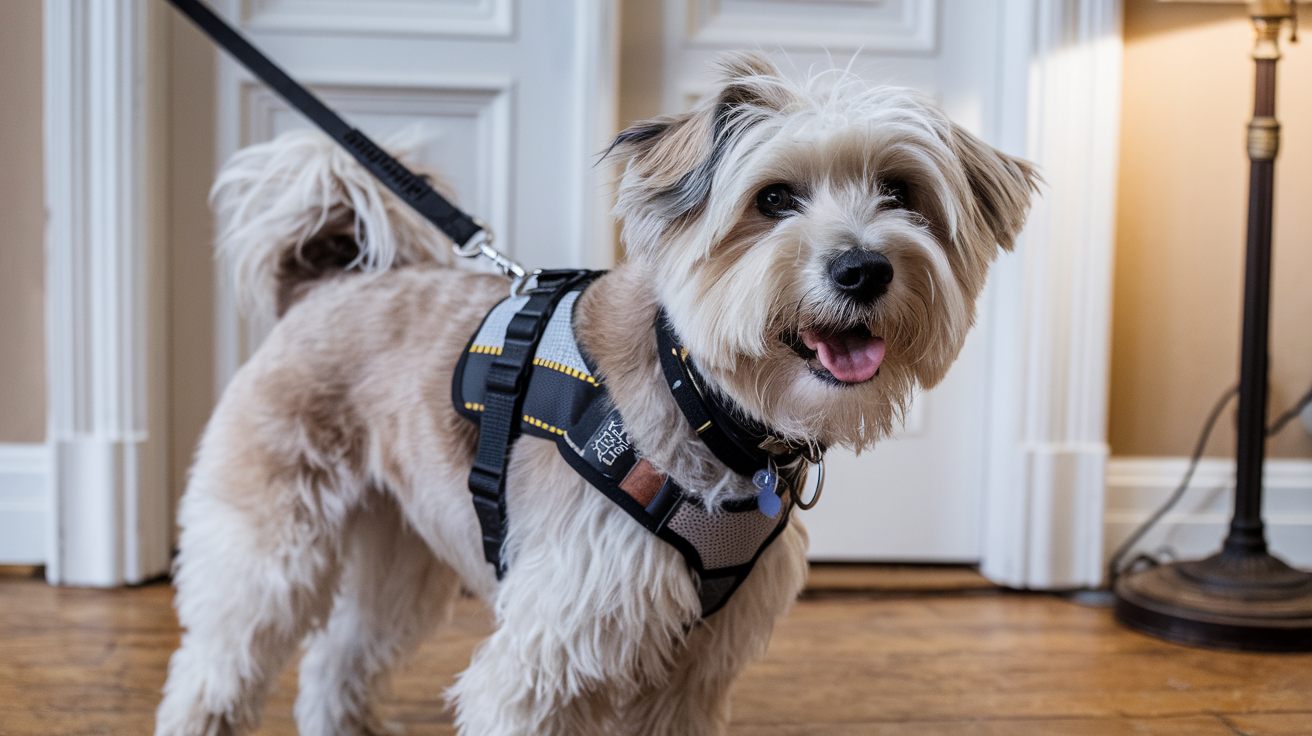Introduction
As a dog owner, you’ve probably stood in the pet store aisle, staring at the overwhelming array of walking equipment and wondered, “Which is actually better for my furry friend?” I know I have! The debate between dog harnesses and collars isn’t just about fashion or convenience—it’s fundamentally about your pet’s safety, comfort, and well-being.
Whether you’ve just welcomed a new puppy into your home or you’re reconsidering your longtime companion’s walking gear, this choice matters more than you might think. The right equipment can prevent injuries, make walks more enjoyable, and even help with training challenges like pulling.
In this guide, we’ll explore everything you need to know about harnesses versus collars, diving into the pros and cons of each option, how to choose the right one for your specific dog, and when each option shines. Let’s help you make an informed decision that keeps your four-legged friend safe and happy!
Understanding the Basics: Harnesses vs. Collars
What is a Dog Harness?
A dog harness is a piece of equipment that wraps around your dog’s chest and torso, distributing pressure across a larger area of the body rather than concentrating it on the neck. Harnesses come in various styles, including:
- Back-clip harnesses: With attachment points on the dog’s back
- Front-clip harnesses: With attachment points on the dog’s chest
- Dual-clip harnesses: Offering both front and back attachment options
- Step-in harnesses: That dogs can simply step into before being secured
Harnesses were originally designed for working dogs who needed to pull loads, but they’ve evolved into everyday walking equipment for pets of all kinds.
What is a Dog Collar?
A dog collar is the traditional option—a strap that goes around your dog’s neck, typically featuring a D-ring for attaching identification tags and connecting a leash. Collars come in several varieties:
- Flat collars: The standard everyday option
- Martingale collars: That tighten slightly when pulled but won’t choke
- Roll collars: Rounded designs that reduce matting in long-haired breeds
- Breakaway collars: With safety features that release under pressure
Most dog owners use collars at minimum for ID purposes, even if they prefer harnesses for walking.
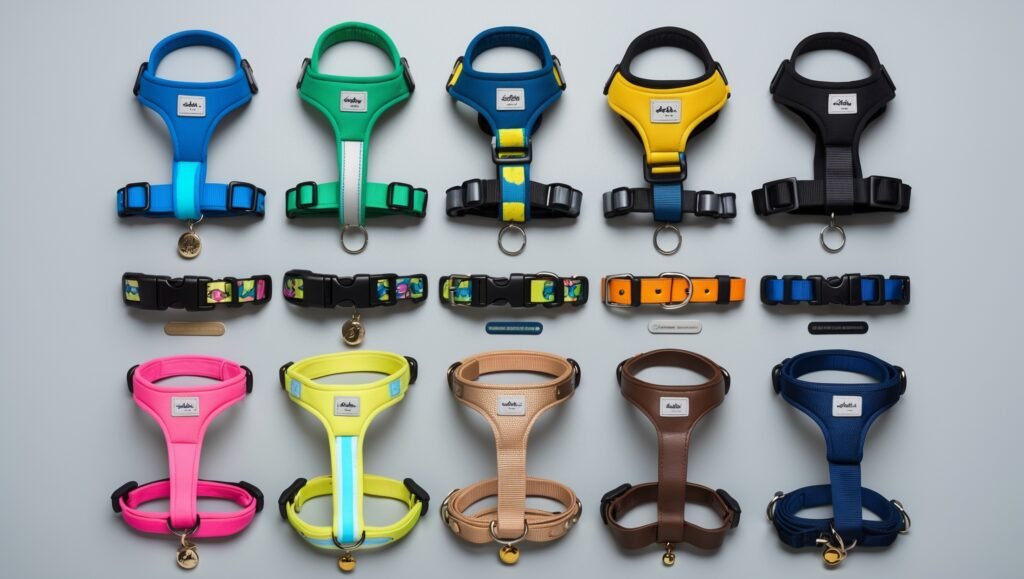
Safety Comparison: Harnesses vs. Collars
Physical Safety Considerations
When it comes to physical safety, harnesses generally have the edge for most dogs. Here’s why:
Harness Safety Benefits:
- Reduced neck strain: Harnesses distribute pulling forces across the chest and shoulders rather than concentrating pressure on the delicate neck area.
- Lower risk of tracheal injury: Particularly important for small breeds, brachycephalic (flat-faced) dogs, and those with respiratory issues.
- More control: Especially useful for strong dogs or those who tend to lunge.
- Escape prevention: Many harnesses are more secure for dogs who might slip out of a collar.
- Spinal protection: Prevents jerking motions from impacting the spine and neck.
Collar Safety Concerns:
- Tracheal collapse risk: Particularly in small breeds like Chihuahuas, Yorkies, and Pomeranians.
- Increased intraocular pressure: Studies have shown that pulling against a collar can raise pressure in a dog’s eyes.
- Thyroid damage potential: The thyroid gland sits in the neck area and can be impacted by consistent pressure.
- Neurological issues: In extreme cases, collar pressure can affect nerves in the neck.
- Whiplash potential: Sudden stops or jerks can cause whiplash-like injuries.
Behavioral Safety Considerations
Beyond physical safety, there are behavioral aspects to consider:
Harness Behavioral Benefits:
- Reduced pulling behavior: Especially with front-clip harnesses that use the natural opposition reflex.
- Lower frustration levels: Dogs who pull against collars often become more agitated and frustrated.
- Better training outcomes: Many trainers recommend harnesses for positive reinforcement training.
- Reduced redirected aggression: Less neck pressure means fewer pain triggers that might cause reactivity.
Collar Behavioral Concerns:
- Potential aggravation of reactivity: Discomfort from pulling can exacerbate reactive behaviors.
- Pain association: Dogs may associate pain from collar pressure with whatever they’re looking at (other dogs, people, etc.).
- Increased arousal: Pressure on the neck can trigger an arousal response in some dogs.
Dr. Alexandra Horowitz, canine cognition expert, notes, “The pressure of a collar pulling against a dog’s neck can create an unintended negative association with whatever the dog is looking at or experiencing in that moment.”
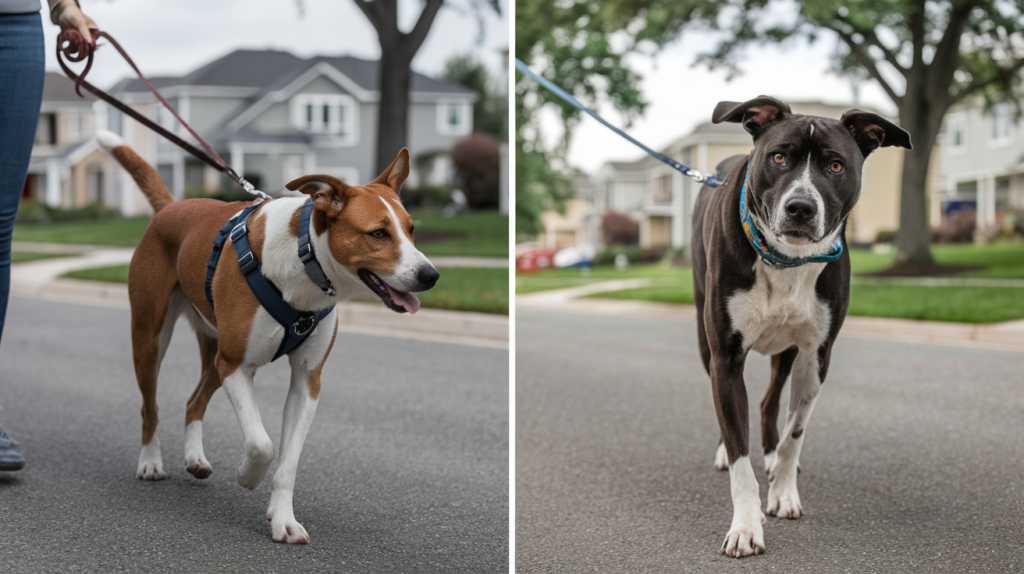
When Harnesses Are the Better Choice
Harnesses shine in many situations and for many types of dogs. Consider a harness if:
Dog-Specific Factors:
- Your dog is a brachycephalic breed (Bulldog, Pug, Boston Terrier, etc.) with breathing challenges
- Your dog has a medical history of tracheal issues, neck injuries, or back problems
- You have a small breed whose delicate trachea is more susceptible to collapse
- Your dog is an escape artist who can slip out of collars
- You’re dealing with a strong puller who needs better control
Activity-Specific Considerations:
- For high-energy activities like running, hiking, or agility training
- During training sessions, especially loose-leash walking practice
- In car travel where a crash-tested harness provides safety
- For service or working dogs who need the additional control and attachment points
I remember when my Border Collie mix, Max, was recovering from a neck strain. Switching him to a padded, back-clip harness made an immediate difference in his comfort level during walks. His whole body language changed—head up, tail wagging, no more wincing when he saw the leash come out.
When Collars Make More Sense
Despite the advantages of harnesses, collars still have their place in dog care:
Dog-Specific Factors:
- Your dog is well-trained and walks nicely on leash without pulling
- Your dog has skin sensitivities in areas where harnesses rub
- You have a dog with a body shape that makes most harnesses fit poorly (very deep-chested or unusual proportions)
- Your dog strongly dislikes the feeling of a harness
Activity-Specific Considerations:
- For ID purposes (most dogs should wear a collar with tags even if walked on a harness)
- Very brief potty breaks where control is less important
- Supervised off-leash activities where the collar is just for emergency grabbing
- Certain dog sports that require collar use
My neighbor’s Greyhound, Luna, has extremely sensitive skin that gets irritated under harnesses, no matter how padded or well-fitted. For her, a wide, padded collar makes more sense for their calm daily walks.
Comparing Different Types of Harnesses
Not all harnesses are created equal. Here’s a breakdown of the main types:
| Harness Type | Best For | Main Benefits | Potential Drawbacks |
|---|---|---|---|
| Back-Clip | Well-trained dogs; routine walks | Comfortable; easy to put on; doesn’t restrict movement | May encourage pulling in untrained dogs |
| Front-Clip | Dogs learning leash manners; pullers | Discourages pulling; gives more steering control | Can restrict natural movement; may twist |
| Dual-Clip | Versatile use; dogs in training | Flexibility for different situations; better control | Usually more expensive; can be bulkier |
| Step-In | Dogs who dislike things going over their head | Easy to put on; less intimidating | May not be as secure for strong pullers |
| Y-Shaped | Active dogs needing range of motion | Allows free shoulder movement; less chafing | May not provide as much control for pullers |
| Vest-Style | Small dogs; dogs needing emotional security | Distributes pressure very evenly; often padded | Can be hot; may be too bulky for some dogs |
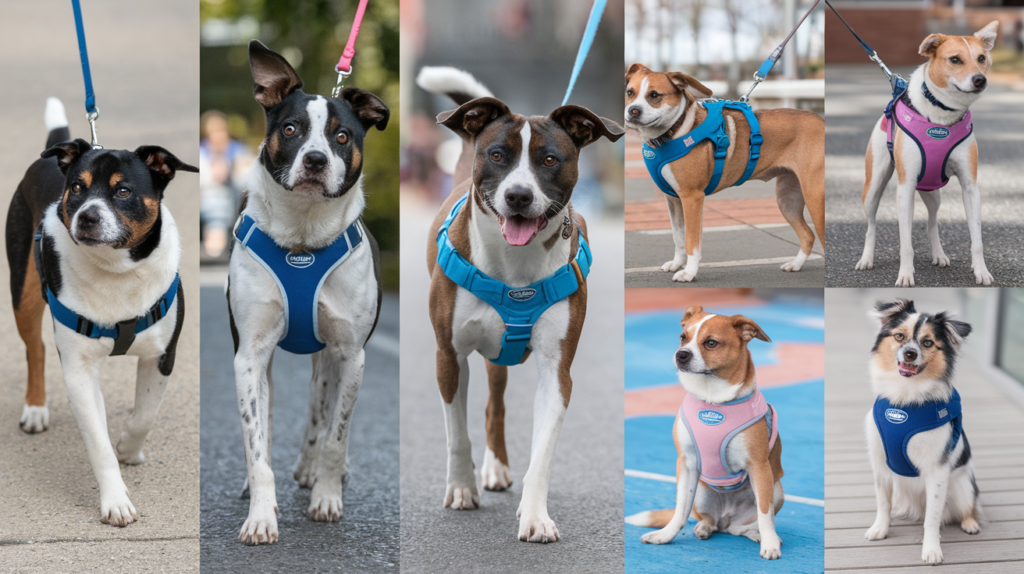
Comparing Different Types of Collars
Similarly, collars come in various designs for different purposes:
| Collar Type | Best For | Main Benefits | Potential Drawbacks |
|---|---|---|---|
| Flat Collar | ID tags; well-trained dogs | Simple; comfortable for daily wear | Provides little control for pullers; safety risks |
| Martingale | Dogs with narrow heads; mild pullers | Prevents escape; gentler than choke collars | Still applies pressure to neck when tightened |
| Roll Collar | Long-haired breeds | Reduces matting and hair breakage | Limited control; same safety concerns as flat collars |
| Breakaway | Supervised outdoor time; safety concerns | Releases if caught on something | Not suitable for leash attachment |
| GPS Collar | Dogs with roaming tendencies | Tracking capabilities | Bulkier; expensive; still has safety concerns of regular collars |
How to Choose the Right Size Harness for Your Dog
Getting the right fit is crucial for harness safety and effectiveness. Here’s how to measure your dog:
- Chest girth: Measure the widest part of your dog’s chest, usually just behind the front legs.
- Neck girth: Measure around the base of your dog’s neck where a collar would sit.
- Body length: For some harness styles, measure from the base of the neck to the base of the tail.
Most manufacturers provide sizing charts based on these measurements, but remember that they can vary between brands. When trying a harness:
- You should be able to fit two fingers between the harness and your dog’s body.
- The harness shouldn’t rub against your dog’s armpits or restrict shoulder movement.
- All straps should lie flat without twisting.
- Your dog should still be able to move naturally and comfortably.
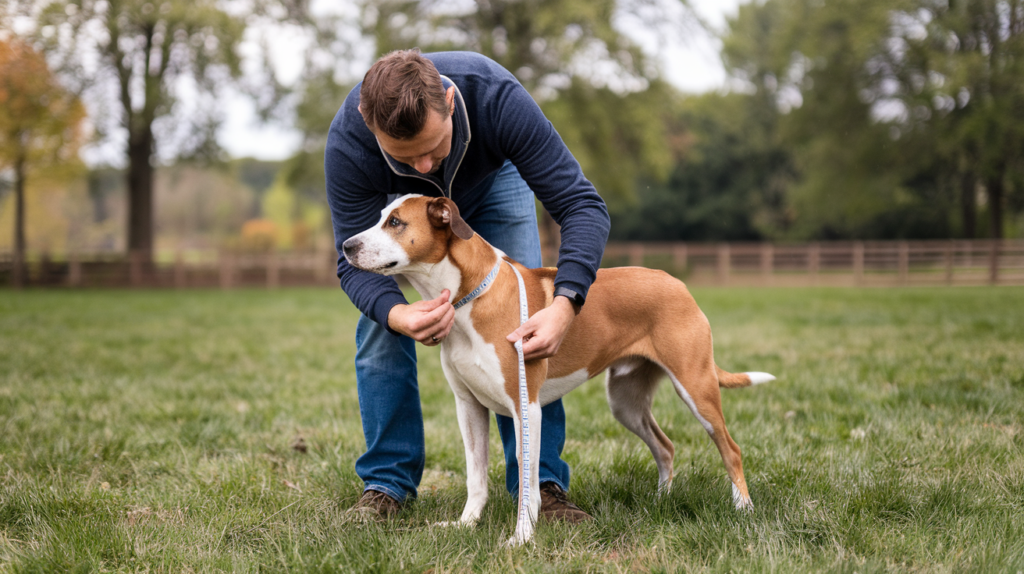
How to Properly Put On a Dog Harness
One of the challenges with harnesses is learning how to put them on correctly. Here’s a simple guide:
For Over-the-Head Harnesses:
- Loosen all straps first.
- Slip the neck piece over your dog’s head.
- Bring the bottom straps between the front legs.
- Buckle the side straps around your dog’s body.
- Adjust all straps for a proper fit.
For Step-In Harnesses:
- Lay the harness flat on the ground.
- Have your dog step into the leg holes.
- Pull the harness up around your dog’s body.
- Fasten the buckles on your dog’s back.
- Adjust for fit.
The first few times, use treats and praise to create a positive association. With practice, most dogs quickly get used to the routine.
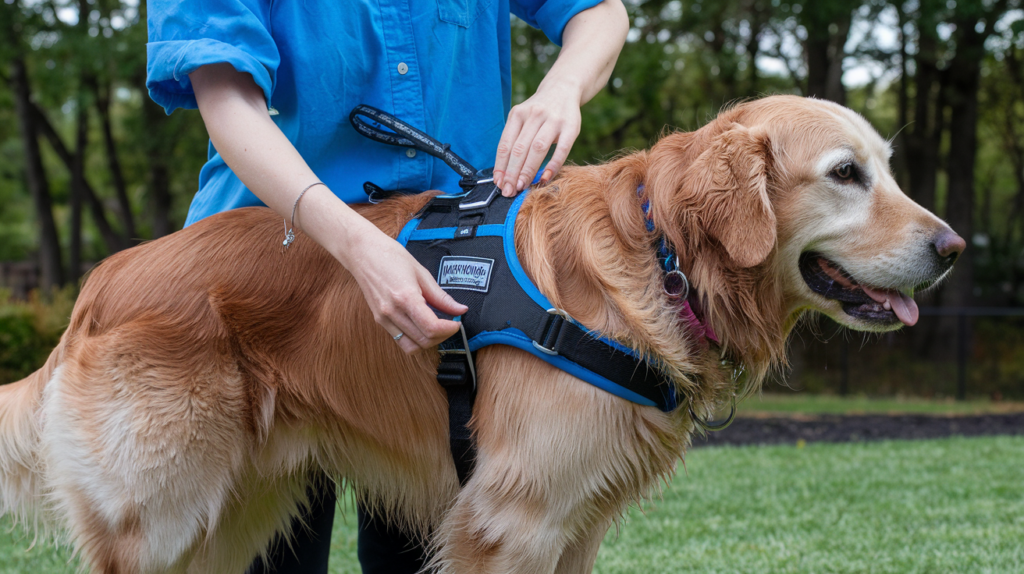
Harness Maintenance and Care
To keep your dog’s harness in good condition:
- Clean regularly: Most harnesses can be hand-washed with mild soap and air-dried.
- Check for wear: Inspect buckles, stitching, and attachment points before each use.
- Replace when necessary: Fraying, significant wear, or broken components mean it’s time for a new harness.
- Store properly: Keep harnesses away from extreme temperatures and direct sunlight when not in use.
Cleaning frequency depends on your dog’s activity level, but a good rule of thumb is to wash fabric harnesses every 2-3 weeks for active dogs, or whenever they become visibly dirty or smelly.
Top Harness Recommendations for Different Dog Types
Based on extensive research and user feedback, here are some top harness options for specific needs:
For Everyday Use:
- Ruffwear Front Range Harness: All-day comfort with padded chest and belly panels, suitable for various activities.
- Rabbitgoo No-Pull Dog Harness: Features two leash attachments and is made of breathable padded material.
For Training/No-Pull Solutions:
- 2 Hounds Design Freedom No-Pull Harness: Includes a patented control loop to discourage pulling.
- PetSafe Easy Walk Harness: Designed to gently discourage pulling during walks.
For Car Safety:
- Kurgo Tru-Fit Smart Harness: Crash-tested for car safety with all-steel nesting buckles.
For Small Breeds:
- Gooby Comfort X Step-In Harness: Ideal for small dogs, with a step-in design for easy use.
- Puppia Soft Dog Harness: Lightweight and breathable, perfect for small breeds.
For Large/Strong Dogs:
- Julius-K9 IDC Powerharness: Sturdy harness with an adjustable chest strap and reflective edges.
- ICEFANG Tactical Dog Harness: Durable harness with MOLLE system for working dogs.
For Active/Outdoor Dogs:
- Hurtta Active Harness: Designed for active dogs with a Y-shaped chest piece for freedom of movement.
- Ruffwear Web Master Harness: Features a handle for assisting dogs over obstacles.
Transitioning Your Dog from Collar to Harness
If your dog has only worn a collar, switching to a harness might require an adjustment period. Here’s how to make the transition smooth:
- Introduce gradually: Let your dog sniff and investigate the harness before putting it on.
- Use positive association: Offer treats and praise as you introduce the harness.
- Keep sessions short: Start with just a few minutes of harness wear, then gradually increase time.
- Make it fun: Play games or offer treats while your dog is wearing the harness.
- Be patient: Some dogs adapt immediately, while others may need several days to adjust.
I’ve found that placing treats inside the harness or feeding meals while showing the harness helps create positive associations. My rescue dog initially froze when I first tried putting a harness on him, but after a week of gradual introduction with lots of chicken treats, he now gets excited when he sees his harness come out!
The Hybrid Approach: When to Use Both
Many experienced dog owners opt for a hybrid approach:
- Collar with ID tags worn at all times for identification
- Harness for walks and activities for better control and safety
- Specific equipment for specific activities (e.g., a lightweight harness for everyday walks, a more secure harness for hiking)
This combination provides the benefits of both options while minimizing the drawbacks of each.
Common Misconceptions
Let’s address some common myths about harnesses and collars:
Myth 1: “Harnesses encourage pulling”
Reality: Only back-clip harnesses might encourage pulling in some dogs. Front-clip harnesses actually discourage pulling by redirecting the dog’s momentum.
Myth 2: “My dog is too small/big for a harness”
Reality: There are harness options for every size dog, from tiny Chihuahuas to massive Great Danes. It’s about finding the right style and fit.
Myth 3: “Harnesses are too complicated to use”
Reality: While there is a learning curve, most owners find it becomes second nature after a few uses.
Myth 4: “Collars provide better control”
Reality: Harnesses actually offer better control for most dogs, especially those who pull or lunge.
Myth 5: “My dog hates harnesses”
Reality: With proper introduction and fitting, most dogs adapt well to harnesses. Those who seem to “hate” them often have experienced poor fit or improper introduction.
Special Considerations
For Puppies
Puppies have special considerations when it comes to walking equipment:
- Their necks are especially delicate, making harnesses a safer choice
- Their bodies are changing rapidly, requiring frequent size adjustments
- Early positive experiences with harnesses can make lifetime use easier
For Senior Dogs
Older dogs also have unique needs:
- Many develop tracheal weakness with age, making collars riskier
- Joint issues may be exacerbated by the pulling pressure of collars
- Padded harnesses can provide extra support for dogs with mobility challenges
For Dogs with Special Needs
For dogs with specific conditions:
- Orthopedic harnesses can provide support for dogs with mobility issues
- Breathable harnesses are important for dogs with respiratory challenges
- Front-clip harnesses can help manage reactivity in behaviorally challenged dogs
Conclusion: Making the Right Choice for Your Dog
When deciding between a harness and collar, consider:
- Your individual dog’s needs: Their size, breed, health concerns, and behavior
- Your specific activities: Walking, training, hiking, etc.
- Your training goals: Reducing pulling, improving control, or maintaining status quo
In most cases, a properly fitted harness will be the safer option, particularly for:
- Small breeds
- Dogs with respiratory issues
- Strong pullers
- Escape artists
- Dogs recovering from injuries
However, a well-fitted collar may be sufficient for:
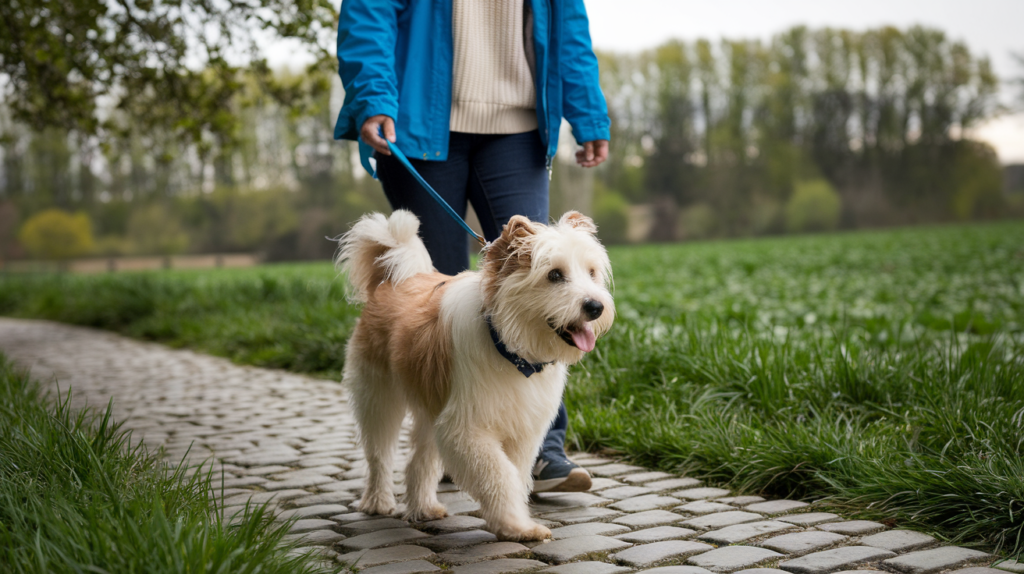
- Well-trained dogs who don’t pull
- Brief supervised outings
- Dogs with specific skin sensitivities
- ID tag purposes
Remember, there’s no one-size-fits-all answer. The best choice is the one that keeps your specific dog safe, comfortable, and happy during your shared activities.
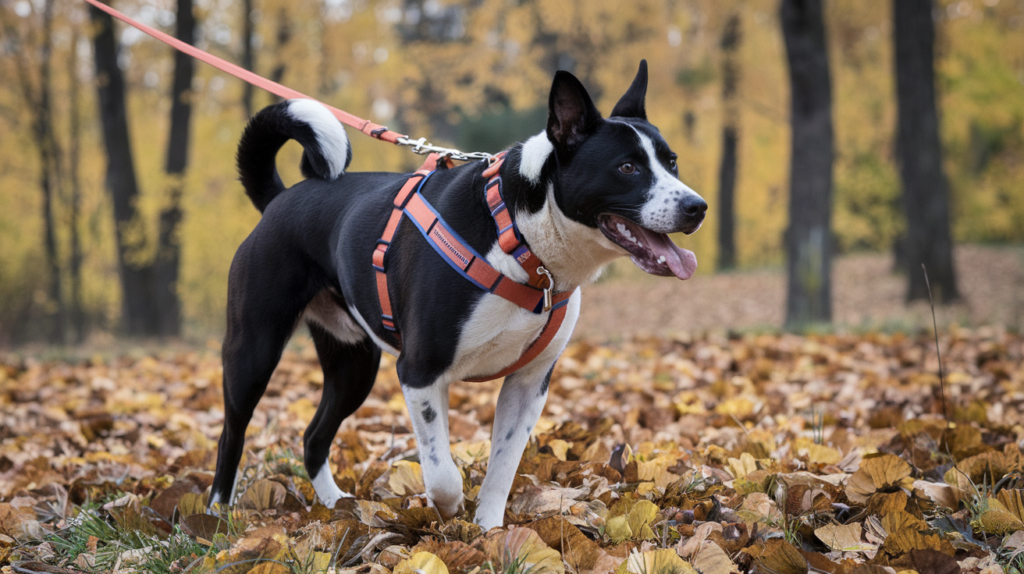
What’s your experience with harnesses versus collars? Have you found one works better for your dog than the other? Consider trying a new option if you’re experiencing challenges with your current setup—you might be surprised by the difference it makes in your daily walks!
Frequently Asked Questions
1. How do I choose the right size harness for my dog?
Measure your dog’s chest girth (the widest part behind the front legs), neck circumference, and sometimes body length. Compare these measurements to the manufacturer’s sizing chart, as sizes can vary between brands. Allow for two fingers of space between the harness and your dog’s body for comfort.
2. What’s the difference between a front-clip and back-clip harness?
Front-clip harnesses have the leash attachment point on the dog’s chest, which helps discourage pulling by redirecting the dog when they pull forward. Back-clip harnesses have the attachment point on the dog’s back, which is more comfortable for dogs who don’t pull and allows for more natural movement.
3. Can my dog wear a harness all day?
While many harnesses are designed for comfort, it’s generally not recommended to leave a harness on all day. It can cause chafing, matting of fur, skin irritation, or pressure sores. Remove the harness when not actively walking or supervising your dog.
4. How do I prevent chafing or rubbing from a dog harness?
Choose a harness with padding in potential friction areas, ensure proper fit with adjustable straps, opt for harnesses with wide straps to distribute pressure evenly, and regularly check for any signs of irritation. For dogs with sensitive skin, look for harnesses made from soft, breathable materials.
5. Are harnesses better than collars for walking dogs?
Harnesses are generally safer than collars for walking most dogs, as they distribute pressure across the chest and shoulders rather than the neck, reducing the risk of tracheal damage, thyroid issues, and increased eye pressure. They’re particularly beneficial for dogs who pull, have respiratory issues, or neck/back problems.
This article contains affiliate links, meaning I may earn a commission if you click through and make a purchase at no extra cost to you.

